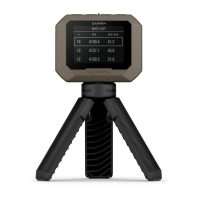Garmin entered the firearms accessories market long after establishing themselves in GPS and aviation electronics, but their Xero ballistic chronographs have become a popular option for shooters who want simple, repeatable velocity data for load development and trajectory validation. The Garmin Xero series uses radar-based velocity measurement instead of optical sensors, and integration with Garmin’s ShotView app and other ballistic tools makes the system particularly useful for precision rifle shooters working up loads or verifying factory ammunition performance.
Garmin Chronographs
The Garmin rifle chronograph range currently centers on the Xero C1 Pro, a compact radar chronograph that measures projectile velocities from roughly 100 to 5,000 feet per second, depending on the type of projectile. It mounts on a standard tripod, sits beside your shooting position rather than downrange, and records velocity, shot count, extreme spread, and standard deviation automatically. The unit displays results on an integrated screen and pairs with smartphones via Bluetooth for detailed analysis in the ShotView app. We stock Garmin Xero chronograph models at No Boring Guns because they solve the setup problems that make optical chronographs frustrating in field conditions: there is no need to place sky screens downrange or worry about shifting light conditions.
Ballistic Devices and GPS Systems
Garmin ballistic products extend beyond chronographs to rangefinding optics and ballistic-capable devices that can work with environmental and positional data. Their GPS units, while primarily designed for navigation, outdoor recreation, and fitness tracking, are widely used by hunters for waypoint marking, tracking routes, and terrain mapping. These are not firearms-specific products, but Garmin’s experience with accurate positioning, sensors, and rugged outdoor electronics translates well to shooting and hunting applications.
Why We Carry These Products
Garmin products for sale at No Boring Guns serve handloaders and precision shooters who need reliable velocity data without the lighting sensitivity and setup complexity of traditional optical systems. The Xero chronographs sit in the higher price bracket compared to basic chronographs, but in return you get radar-based measurement, quick setup at the firing line, and straightforward data export for anyone doing serious load development or tracking long term performance. They are particularly popular with customers who shoot at multiple ranges or in varied conditions where setting up traditional chronographs becomes impractical.
FAQs
Is the Garmin chronograph worth it?
For shooters who develop loads regularly or need velocity data in varied field conditions, the investment often makes sense because radar measurement removes much of the setup complexity and lighting sensitivity that comes with optical chronographs. You position the unit beside your shooting bench instead of downrange, and it captures consistent data across a wide range of projectile types. The cost premium over basic chronographs is mainly justified by faster setup, fewer missed shots, and better usability if you work up loads frequently enough that convenience and reliability matter.
Is Garmin a German company?
No. Garmin is an American multinational technology company with operational headquarters in Olathe, Kansas. It was founded in 1989 by Gary Burrell and Min Kao, and the Garmin name comes from combining their first names. The company is legally domiciled in Switzerland and operates engineering, manufacturing, and support centers in the United States, Taiwan, and other regions, but it does not have a German origin.
Does the US military use Garmin?
Garmin produces several GPS devices and tactical watches that are built to U.S. military durability standards and are marketed toward military and professional users, and many individual service members and units use commercial Garmin devices for navigation and fitness. However, detailed information about specific U.S. military procurement and official issue lists is not fully public, and sensitive applications rely on dedicated military systems. In practice, Garmin products should be viewed as robust commercial off-the-shelf tools that can complement, but not replace, purpose-built military equipment.
























